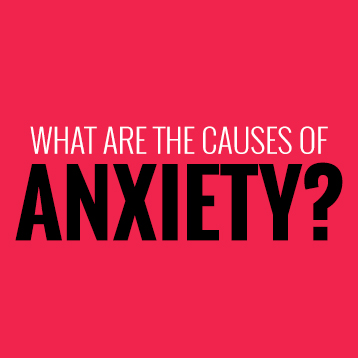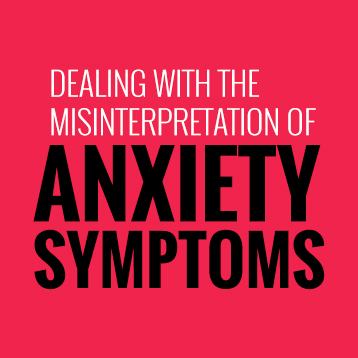When we are facing a dangerous or life threatening situation, our bodies are naturally built to enter a state of alertness. Our heart-rate increases, we start to shake, and we feel nervous or scared. In other words, we experience fear. This alertness prepares us physically in order to either fight the threat, or run away from it [1]. This reaction is not only natural, but also helpful. For instance, if we suddenly see a car quickly speeding towards us while we are crossing the street, we immediately start to run because we fear that it will hit us. In this case, fear saves our life. On the other hand, when we become worried about an issue that will take place sometime in the future, we are experiencing anxiety. Anxiety can also be helpful. For example, if a student is anxious about an exam she/he has the following week, she/he is likely to study hard in order to prepare for it.
However, if you are experiencing extreme, irrational fear, and/or intense worry that affects your everyday life, you may be suffering from an anxiety disorder. To give a few examples, you may experience intense worry that you find hard to control, feel restless or on edge, become easily tired, find it difficult to concentrate, become easily irritated, suffer from tense muscles (for instance, low back pain, headaches or stomach aches), and/or have problems with sleep (for example, finding it hard to fall asleep, or waking up in the middle of the night). These would all indicate that your anxiety levels are higher than normal.
If you want to check your anxiety levels, feel free to fill out the questionnaire at the end of this page.
It is important to note that if you have experienced a period of:
- Intense anxiety
- Terror
- Feeling that something bad is about to happen
And these were accompanied by at least four of the following symptoms:
- Difficulty in breathing
- Heart is racing
- Nausea
- Upset stomach
- Chest pain
- Feeling as if you are choking
- Feeling dizzy
- Feeling lightheaded
- Sweating
- Having chills or Having hot flashes
- Trembling
- Feeling as if you’re being outside your body
- Feeling as if the world is not real
- Afraid of losing control
- Afraid you are going crazy
- Afraid you are going to die
Panic attack symptoms usually appear suddenly and very quickly and reach their highest intensity within ten minutes. While experiencing a panic attack once or twice in our life can be quite common [2], you may be suffering from Panic Disorder if:
- You have repeatedly experienced panic attacks that were not triggered by a specific situation
- For at least one month, you are worried that you may experience another panic attack, you are worried about the consequences of a panic attack, or you have changed your behaviour because of the panic attacks (for example, avoiding going out because you are afraid of having a panic attack in public)American Psychiatric Association. (1994). Diagnostic and statistical manual of mental disorders. (DSM-IV). (4th ed.). Washington, DC: Author.
The symptoms of a panic attack are the result of the body going into a state of alertness which, as mentioned above, prepares the person to either face or run away from a threatening situation. But since in Panic Disorder the attacks appear unexpectedly, without a threat triggering them, for someone who doesn’t know that they are having a panic attack experiencing these symptoms can be scary and because they cannot explain them, it is no surprise that many people may mistake their panic attack symptoms as having a heart attack or a nervous breakdown.

Genetic and biological factors have been associated with anxiety disorders, but so are a person’s social environment, way of thinking, and personality. For example, people who are generally anxious, insecure, and tend to worry about things, are more likely to develop an anxiety disorder [3]. It has even been proposed that babies who have a tendency to become stressed and cry when introduced to new toys or people are likely to develop anxiety symptoms later in their childhood [4].
In terms of social environment, most people have experienced an extremely stressful event in their lives before developing an anxiety disorder [5]. It goes without saying that being a victim of domestic abuse is an extremely negative and stressful situation. Not only do victims of abusive relationships go through traumatic events such as physical and/or emotional abuse, but also they can live in constant fear that their abuser will hurt them or their loved ones at any time. Constantly being on edge, waiting for the next abusive incident to inevitably take place, and always feeling as if you need to walk on eggshells in order to not upset your abuser can lead you to continuously feel anxious. In fact, in a study that surveyed female victims of domestic violence in urban and rural areas in India, of 9938 women surveyed, 40% reported poor mental health. [6]
Furthermore, thinking that you don’t have control over your environment, can also increase your chances of developing an anxiety disorder [7][8]. Abusive relationships are all about the control that the abuser has over his victim. Having your abuser control you in any way can make you feel as though you have no control over your own life and that can lead you to become stressed. No one deserves to have others dictate them how to live their lives or endure constantly threatening situations. Find hope in the fact that there are ways to deal with abusive relationships. To find more, please click here
People suffering from extreme anxiety have also been found to pay more attention to things that are considered stressful [9] and have a tendency to interpret situations in a negative manner [10]. Therefore, a person suffering from Panic Disorder can be more likely to notice and pay attention to the initial symptoms of a panic attack (such as shortness of breath and increased heart rate), and wrongly interpret them as a heart attack. Of course, this misinterpretation can make them feel even more stressed. Some people may even begin to avoid engaging in any situations that make their heart race (for example, exercise) because as soon as they feel their heart rate increase, they are scared of an oncoming heart attack. However, this behaviour strengthens and maintains their false belief that the only reason why they haven’t actually had a heart attack is the fact that they avoid engaging in situations that increase their heart rate [11], and creates a vicious cycle of fear, stress, and avoidance.
It has even been suggested that people can suffer from anxiety because it distracts them from even more intense negative emotions [12]. If this is the case, it could offer an additional explanation as to why women in abusive relationships are more likely to suffer from anxiety disorders: it might be that intense worry feels less damaging than the reality victims of domestic abuse are facing on a daily basis, and therefore could be used as a distraction from the negativity that surrounds their everyday lives.

‘Two men looked out from prison bars, one saw the mud, the other saw the stars.’
Frederick Langbridge
As we have mentioned above, in abusive relationships the abuser wants to have total control over his victim. Firstly, it is important to note that even though you may feel that you have no control over the negative situations that occur in your life, know that there are ways to escape this situation and reclaim your right to decide what you do with your life. However, even if you cannot get out of the relationship at the moment, there are still ways to deal with the situation. Even if you cannot control the events that occur around you at the moment, you can still control the way you react to them. Whether you are leaving or staying, you can find out further information by clicking here.
The first step to dealing with the misinterpretation of anxiety symptoms is to learn what these symptoms are in order to accurately recognise them any time you experience them. This is crucial so that you will break the vicious cycle of ‘anxiety symptoms –> misinterpretation that they are something worse (for example, signs of oncoming heart attack) –> becoming more stressed –> avoid situations that may provoke anxiety symptoms –> belief that disaster (for example, heart attack) was prevented because of our avoidance’. Instead of misinterpreting anxiety symptoms as a sign that something disastrous is about to happen, you should reassure yourself that it is simply your body’s way of telling you that it has gone into a state of alertness, and that the symptoms will go away once you calm down.
You also need to stop maintaining the false belief that avoiding doing certain tasks is what has prevented disaster from happening. In order to do this, you will need to start engaging in activities and behaviours you have been avoiding due to your anxiety symptoms. For instance, if you have been avoiding tasks that increase your heart race, you should start exercising. In fact, exercise has been found to reduce the symptoms of both anxiety and depression [13].
If you feel that you cannot help but be anxious since you always need to be careful not to upset your abuser, you have to realise the fact that unfortunately, abusers will always find a reason to abuse their victims. In fact, they may set their victims up so as to justify their abusive behaviour [14]. You need to realise that you are not being abused because of your actions, but because your partner is abusive and wants to have total control over you. You are not to blame, your abuser is. Therefore, by being anxious over your behaviour you are only making your life even more difficult than it already is. Instead of maintaining high anxiety levels by falsely believing that by being careful enough, you can keep your abuser from abusing you, you should seek help and deal with your anxiety problems and provide yourself with a better quality of life.
If you suspect that you are suffering from increased anxiety, you can fill out the following questionnaire to check your anxiety levels. To learn more about ways to deal with anxiety, please click here.
REFERENCES
[1] Cannon, W.B. (1929). Bodily changes in pain, hunger, fear and rage (rev. ed.). New York: Appleton-Century.
[2] Kessler, R.C., Chiu, W.T., Jin, R., Ruscio, A.M., Shear, K., & Walters, E.E. (2006). The epidemiology of panic attacks, panic disorder, and agoraphobia in the National Comorbidity Survey Replication. Archives of General Psychiatry, 63, 415-424.
[3] de Graaf, R., Bijl, R.V., Ravelli A., Smit, F., & Vollenbergh, W.A.M. (2002). Predictors of first incidence of DSM-III-R psychiatric disorders in the general population: Findings from the Netherlands mental health survey and incidence study. Acta Psychiatrica Scandinavica, 106, 303-313.
[4] Kagan, J., & Snidman, N. (1999). Early childhood predictors of adult anxiety disorders. Biological Psychiatry, 46, 1536-1541.
[5] Finlay-Jones, R. (1989) as cited in Kring, A.M., Johnson, S.L., Davison, G.C., & Neale, J.M. (2010). Abnormal Psychology (11th ed.). Asia: John Wiley & Sons, Inc.
[6] Kumar, Shuba, LAKSHMANAN JEYASEELAN, SARADHA SURESH, and Ramesh Chandra Ahuja. “Domestic Violence and Its Mental Health Correlates in Indian Women.” BJPsych. The British Journal of Psychology, 30 June 2005. Web. 21 Feb. 2015. <http%3A%2F%2Fbjp.rcpsych.org%2Fcontent%2F187%2F1%2F62>.[7] Mineka, S., & Zinbarg, R. (1998) as cited in Kring, A.M., Johnson, S.L., Davison, G.C., & Neale, J.M. (2010). Abnormal Psychology (11th ed.). Asia: John Wiley & Sons, Inc.
[8] Insel, T.R., Scanlan, J., Champoux, M., & Suomi, S.J. (1988). Rearing paradigm in a nonhuman primate affects response to B-CCE challenge. Psychopharmacology, 96, 81-86.
[9] MacLeod, C., Mathews, A., & Tata, P. (1986). Attentional bias in emotional disorders. Journal of Abnormal Psychology, 95, 15-20.
[10] Hirsch, C., & Mathews, A. (2000). Impaired Positive Inferential Bias in Social Phobia. Journal of Abnormal Psychology, 109, 705-712.
[11] Clark, D.M., Salkovskis, P.M., Hackmann, A., Wells, A., Ludgate, J., & Gelder, M. (1999). Brief cognitive therapy for panic disorder: a randomized control trial. Journal of Consulting and Clinical Psychology, 67, 583-589.
[12] Borcovec, T.D., & Newman, M.G. (1998) as cited in Kring, A.M., Johnson, S.L., Davison, G.C., & Neale, J.M. (2010). Abnormal Psychology (11th ed.). Asia: John Wiley & Sons, Inc.
[13] Salmon, P. (2001). Effects of physical exercise on anxiety, depression, and sensitivity to stress: a unifying theory. Clinical Psychology Review, 21(1), 33-61.
[14] Walker, L. E. (1979). The battered woman. New York: Harper & Row.

